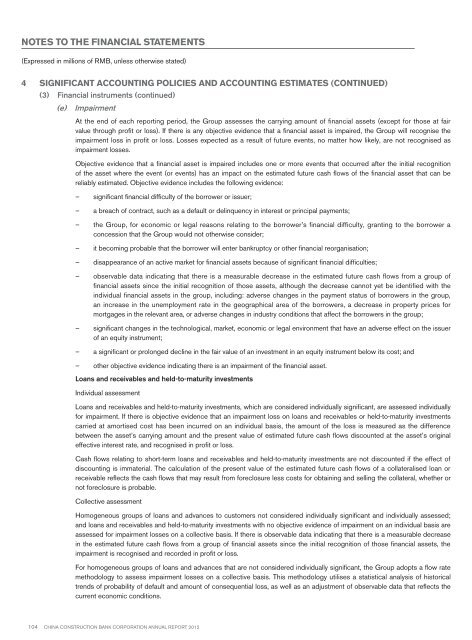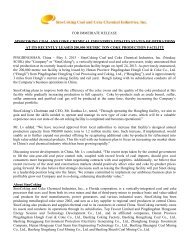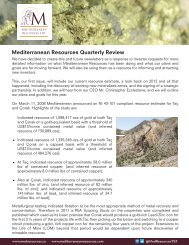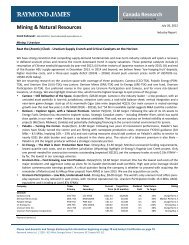Annual Report 2012
Annual Report 2012
Annual Report 2012
- No tags were found...
You also want an ePaper? Increase the reach of your titles
YUMPU automatically turns print PDFs into web optimized ePapers that Google loves.
Notes to the financial statements(Expressed in millions of RMB, unless otherwise stated)4 Significant accounting policies and accounting estimates (continued)(3) Financial instruments (continued)(e)ImpairmentAt the end of each reporting period, the Group assesses the carrying amount of financial assets (except for those at fairvalue through profit or loss). If there is any objective evidence that a financial asset is impaired, the Group will recognise theimpairment loss in profit or loss. Losses expected as a result of future events, no matter how likely, are not recognised asimpairment losses.Objective evidence that a financial asset is impaired includes one or more events that occurred after the initial recognitionof the asset where the event (or events) has an impact on the estimated future cash flows of the financial asset that can bereliably estimated. Objective evidence includes the following evidence:– significant financial difficulty of the borrower or issuer;– a breach of contract, such as a default or delinquency in interest or principal payments;– the Group, for economic or legal reasons relating to the borrower’s financial difficulty, granting to the borrower aconcession that the Group would not otherwise consider;– it becoming probable that the borrower will enter bankruptcy or other financial reorganisation;– disappearance of an active market for financial assets because of significant financial difficulties;– observable data indicating that there is a measurable decrease in the estimated future cash flows from a group offinancial assets since the initial recognition of those assets, although the decrease cannot yet be identified with theindividual financial assets in the group, including: adverse changes in the payment status of borrowers in the group,an increase in the unemployment rate in the geographical area of the borrowers, a decrease in property prices formortgages in the relevant area, or adverse changes in industry conditions that affect the borrowers in the group;– significant changes in the technological, market, economic or legal environment that have an adverse effect on the issuerof an equity instrument;– a significant or prolonged decline in the fair value of an investment in an equity instrument below its cost; and– other objective evidence indicating there is an impairment of the financial asset.Loans and receivables and held-to-maturity investmentsIndividual assessmentLoans and receivables and held-to-maturity investments, which are considered individually significant, are assessed individuallyfor impairment. If there is objective evidence that an impairment loss on loans and receivables or held-to-maturity investmentscarried at amortised cost has been incurred on an individual basis, the amount of the loss is measured as the differencebetween the asset’s carrying amount and the present value of estimated future cash flows discounted at the asset’s originaleffective interest rate, and recognised in profit or loss.Cash flows relating to short-term loans and receivables and held-to-maturity investments are not discounted if the effect ofdiscounting is immaterial. The calculation of the present value of the estimated future cash flows of a collateralised loan orreceivable reflects the cash flows that may result from foreclosure less costs for obtaining and selling the collateral, whether ornot foreclosure is probable.Collective assessmentHomogeneous groups of loans and advances to customers not considered individually significant and individually assessed;and loans and receivables and held-to-maturity investments with no objective evidence of impairment on an individual basis areassessed for impairment losses on a collective basis. If there is observable data indicating that there is a measurable decreasein the estimated future cash flows from a group of financial assets since the initial recognition of those financial assets, theimpairment is recognised and recorded in profit or loss.For homogeneous groups of loans and advances that are not considered individually significant, the Group adopts a flow ratemethodology to assess impairment losses on a collective basis. This methodology utilises a statistical analysis of historicaltrends of probability of default and amount of consequential loss, as well as an adjustment of observable data that reflects thecurrent economic conditions.104 China Construction Bank Corporation annual report <strong>2012</strong>
















